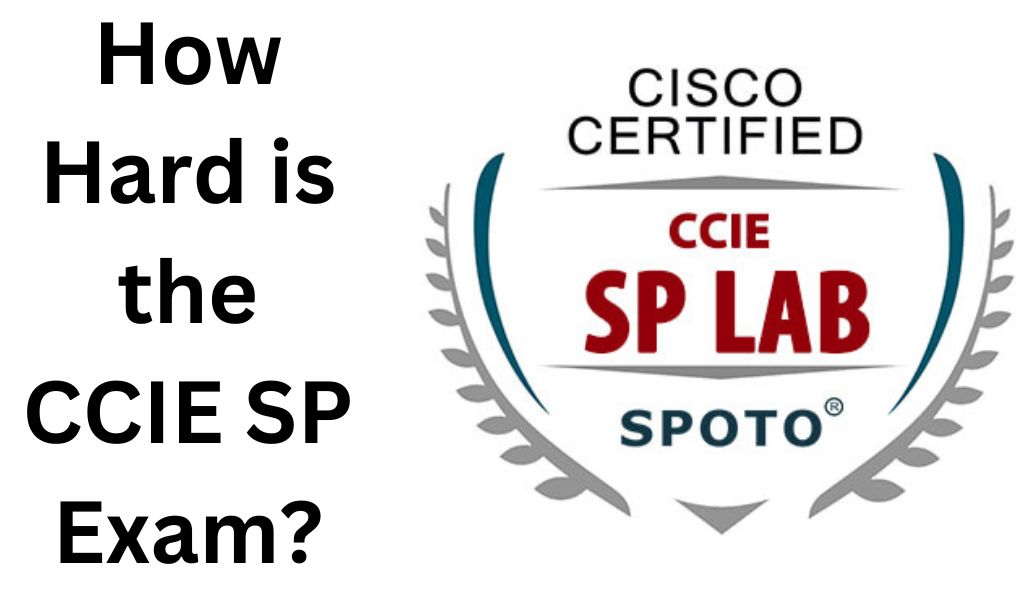Are you ready to take on the ultimate challenge in the world of networking? If you’re a seasoned professional looking to prove your expertise, then the CCIE SP exam might just be the test for you. This coveted certification is renowned for its difficulty and prestige, making it a true testament to one’s skills and knowledge in service provider technologies. But just how hard is the CCIE SP exam? In this blog post, we’ll delve into the structure of the exam and explore what makes it such a formidable undertaking. So buckle up, because we’re about to embark on an exhilarating journey through the world of get SPOTO dumps!
What is the CCIE SP Exam?
The CCIE SP exam, also known as the Cisco Certified Internetwork Expert Service Provider exam, is a rigorous and prestigious certification offered by Cisco. It is designed to validate an individual’s expert-level knowledge and skills in planning, designing, implementing, operating, and troubleshooting complex service provider networks.
This exam focuses on advanced topics related to service provider technologies such as MPLS (Multiprotocol Label Switching), BGP (Border Gateway Protocol), QoS (Quality of Service), multicast protocols, IPv6 deployment strategies, network security, and more. It requires candidates to have a deep understanding of these concepts along with hands-on experience in configuring and managing large-scale service provider networks.
The CCIE SP exam consists of both written and practical lab components. The written exam tests candidates’ theoretical knowledge through multiple-choice questions while the lab component assesses their ability to configure and troubleshoot complex network scenarios within a timed environment.
Due to its comprehensive nature and high level of difficulty, the CCIE SP exam is considered one of the most challenging certifications in the networking industry. Candidates must dedicate significant time and effort to studying various technologies covered in the syllabus, practicing hands-on lab exercises, and staying updated with the latest industry trends.
Successfully passing the CCIE SP exam demonstrates not only technical expertise but also dedication toward professional growth. It opens doors to exciting career opportunities in service provider organizations worldwide.
Read Also: How do I Study for Palo Alto Certification?
The Structure of the CCIE SP Exam
The structure of the CCIE SP exam is designed to thoroughly assess a candidate’s knowledge and skills in various areas related to service provider networking. It consists of two parts: the written exam and the lab exam.
The written exam is a challenging test that covers a wide range of topics, including network architecture, routing protocols, MPLS, QoS, security, and more. It consists of multiple-choice questions and simulations that require candidates to demonstrate their understanding and problem-solving abilities.
Once candidates pass the written exam, they can move on to the lab exam – considered one of the most demanding aspects of becoming a CCIE SP-certified professional. This hands-on practical examination tests candidates’ ability to configure complex networks using real equipment within a specified time frame.
During this eight-hour lab session, participants must complete various tasks such as troubleshooting network issues or implementing specific technologies according to given scenarios. The lab requires not only technical expertise but also excellent time management skills under pressure.
To succeed in this rigorous certification process, aspiring CCIE SP professionals need extensive knowledge coupled with hands-on experience in designing, configuring, and maintaining service provider networks efficiently.
Obtaining a CCIE SP certification showcases an individual’s dedication and expertise in service provider networking while opening doors for exciting career opportunities with top companies worldwide. So if you’re up for the challenge – take it head-on!
How Hard is the CCIE SP Exam?
The CCIE SP exam is widely regarded as one of the most challenging exams in the networking industry. It requires a deep understanding of complex topics and an ability to apply that knowledge in real-world scenarios.
One of the reasons why the CCIE SP exam is so difficult is its comprehensive nature. The exam covers a wide range of topics, including routing protocols, MPLS, QoS, multicast, security, and more. This means that candidates must have a solid grasp of all these areas to succeed.
In addition to breadth, the depth of knowledge required for this exam is also demanding. Candidates need to have an in-depth understanding of technical concepts and be able to troubleshoot complex network issues quickly and effectively.
Moreover, time management plays a crucial role in this exam’s difficulty level. With only eight hours to complete both written and practical sections, candidates are under immense pressure to perform at their best throughout the entire duration.
To pass the CCIE SP exam requires not just theoretical knowledge but also hands-on experience with Cisco technologies. Practical skills are tested through various lab exercises where candidates must configure networks based on specific requirements within strict time constraints.
It’s safe to say that the CCIE SP exam is indeed challenging due to its extensive coverage of topics and rigorous practical testing methods. Success requires dedication, hard work, and practical experience alongside theoretical knowledge – making it truly rewarding for those who attain this prestigious certification.
Conclusion
In this blog post, we have explored the CCIE SP exam and discussed its structure and difficulty level. The CCIE SP exam is a highly challenging certification that tests the knowledge and skills of network engineers in designing, implementing, and troubleshooting service provider infrastructures.
The exam consists of both written and practical lab components. The written exam covers a wide range of topics including routing protocols, MPLS technologies, QoS mechanisms, security features, and network virtualization. It requires extensive study and preparation to pass this part successfully.
The practical lab component is even more demanding as it requires candidates to configure complex networks within a specified timeframe while troubleshooting any issues that may arise. This portion truly tests an engineer’s ability to apply their knowledge in real-world scenarios.
The CCIE SP exam is considered one of the most difficult certifications in the networking industry. It demands deep understanding of various technologies along with hands-on experience in service provider environments. Success requires dedication, hard work, and continuous learning.
However hard it may be though, achieving the CCIE SP certification can greatly enhance your career prospects by showcasing your expertise in service provider networking. It opens up opportunities for higher-level positions with increased responsibilities as well as better salary packages.
So if you are willing to put in the effort and commit yourself to mastering all aspects of service provider networking, then taking on the challenge of the CCIE SP exam could be immensely rewarding for your professional growth learn the CCIE SP.
Remember that success doesn’t come overnight; it comes through persistence and determination. Keep pushing forward toward your goal!



